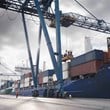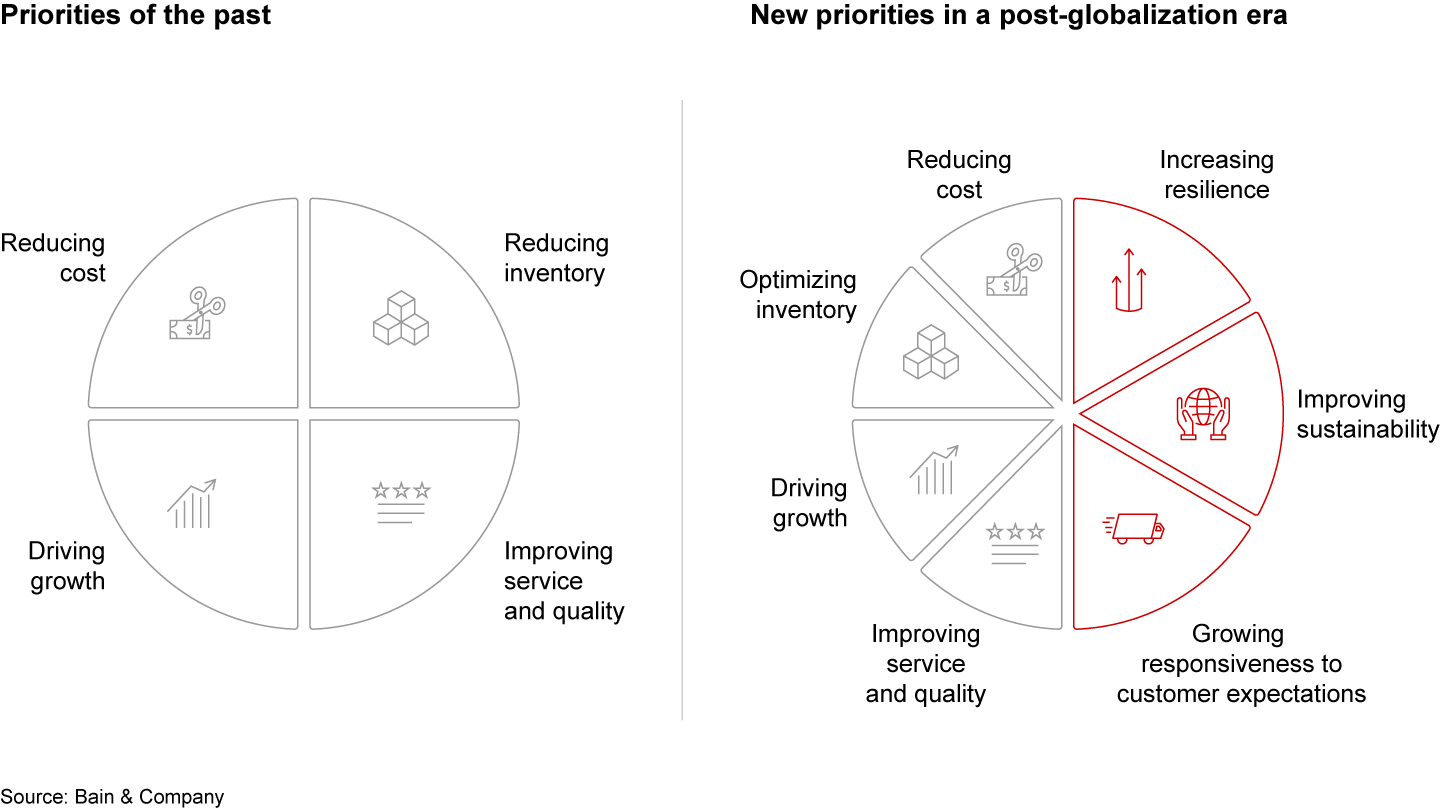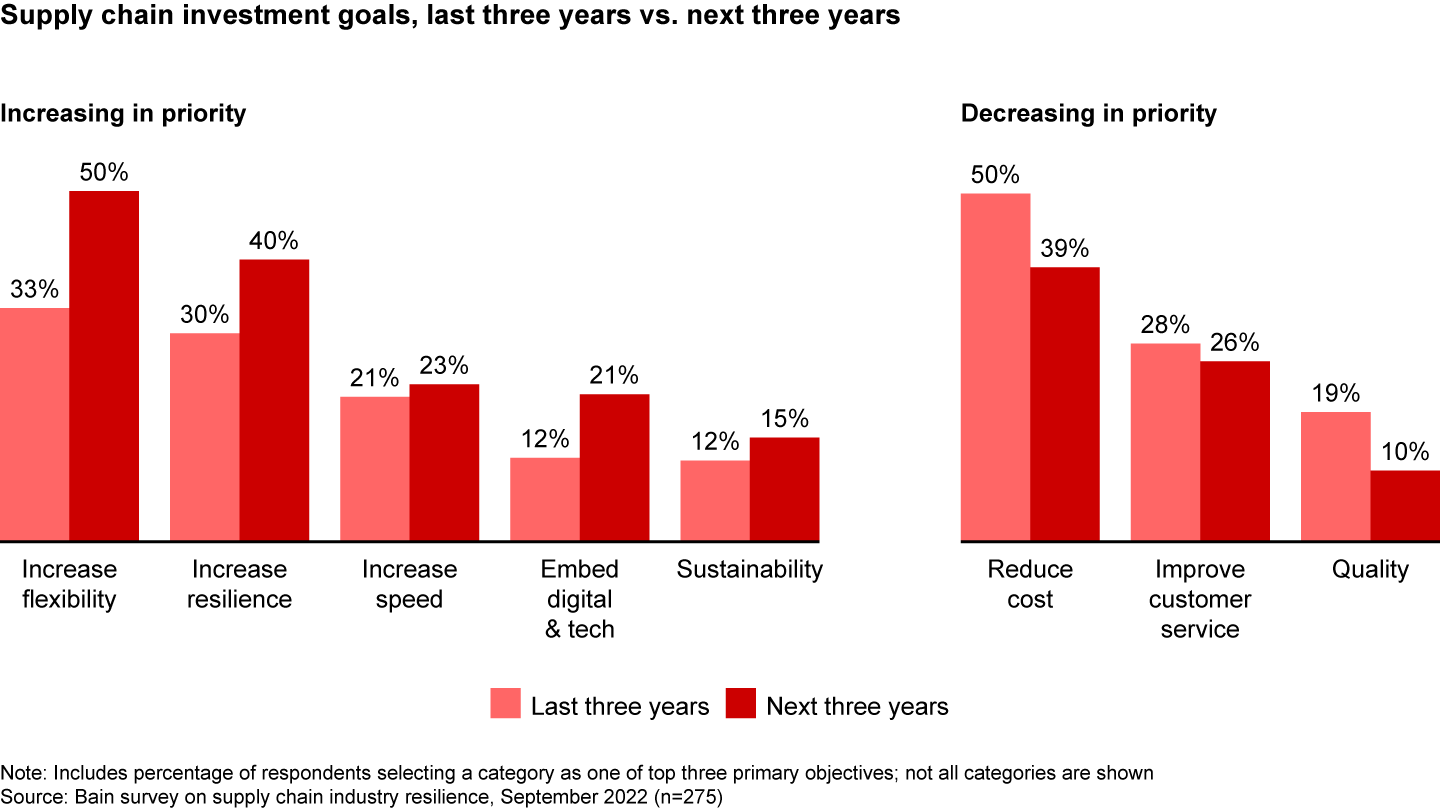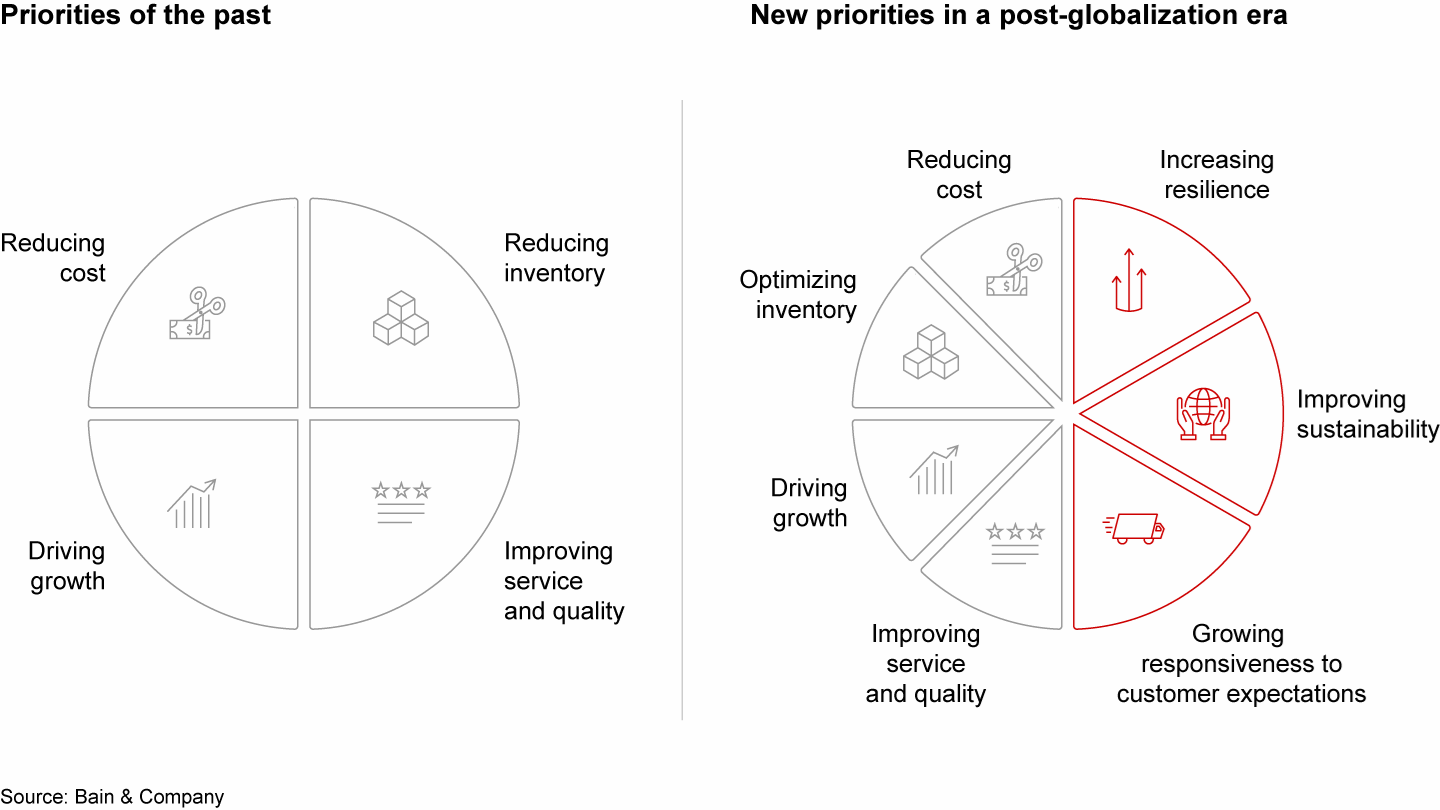Brief

한눈에 보기
- Supply chains now demand more complex trade-offs across a growing set of priorities, including resilience, sustainability, and responsiveness to customers.
- As a result, the operations function is evolving, and supply chain reinvention is a CEO-level problem and opportunity.
- Leading companies employ integrated decision making guided by an understanding of their supply chain’s unique qualities.
- Companies that get the trade-offs right will outperform strategically and set new standards of operational excellence.
It took less than four years of massive global turbulence to upend decades of business dogma about how to design and operate a winning supply chain. Now, the question CEOs must answer is no longer “Should we reinvent our supply chain?” but rather, “How should we reinvent our supply chain?”
Supply chains have weathered multiple large-scale disruptions the past few years, including the devastating Covid-19 pandemic, the global semiconductor shortage, and inflation. Now, the most effective business leaders are applying what they’ve learned to better manage through turbulence. At the same time, they’re grappling with the supply chain implications of several big shifts in the business landscape: labor challenges, stakeholder pressure to decarbonize and improve sustainability of operations, evolving customer expectations, and transformative technologies such as artificial intelligence. They all recognize that turbulence, and its effect on supply and demand, will not subside.
The traditional formula that governed supply chain decisions no longer suffices. Reducing costs, optimizing inventory, improving service and quality, and driving growth remain fundamental priorities. But now, supply chains must also become more resilient, sustainable, and highly responsive to changing customer expectations (see Figure 1).

Executives have been reshuffling priorities in response, according to Bain survey data (see Figure 2).

The reality is that it simply won’t be feasible to make a supply chain 100% resilient, sustainable, responsive, and still cost effective. That said, making only incremental changes won’t be sufficient to compete. Reinventing supply chains for the new world order clearly requires making more complex trade-offs than most operations teams have ever encountered. They’ll need to work closely with teams across and outside the company to find the right solutions.
The bottom line is that reinventing the supply chain is a CEO-level problem—and opportunity. Supply chain operations no longer depend primarily on exceptional execution and continuous improvement; having the right strategy has become even more crucial. Companies that get supply chain trade-offs right will outperform strategically and set new standards of operational excellence. They’ll also find the breakthrough business opportunities that a supply chain reset presents, deploying capital toward bigger and bolder moves. For incumbent leaders, it’s a chance to solidify their position. For followers, this is an opening to leapfrog the competition.
Supply chains’ new look
Successful supply chains will look fundamentally different in this new era. Critical features will include:
- More built-in flexibility. In a world of near-constant turbulence, resilience and adaptability are even more critical. But operational resilience is also very expensive, requiring companies to develop capabilities in monitoring and recovery in addition to flexible design.
- More “split-shoring,” a balance between offshore manufacturing and manufacturing closer to customers and suppliers. More than half of companies plan to increase their supply chain onshoring or “near-shoring” between 2023 and 2025, while decreasing their dependence on China, according to a Bain survey of nearly 300 executives in September 2022. The calculus on low-cost offshore manufacturing hubs has changed as a result of geopolitical instability and the desire to deliver products faster, more reliably, and with a lower carbon footprint. Shorter supply chains can address all three considerations.
- More visibility into the whole chain, thanks to better data, digital tools, and relationships with suppliers and partners. In particular, digital traceability—allowing companies to see what’s happening in their supply chain in real time and from end to end—will be the greatest enabler of the supply chains of the future. Feeding that data into advanced software models and artificial intelligence technologies will unlock huge benefits: more easily spotting and responding to risks and disruptions, adapting to customer needs and customizing by segment, making more informed decisions about supply chain investment trade-offs, and better tracking and certifying sustainability outcomes. For example, clothing designer Ralph Lauren launched a project that assigns garments a unique digital ID, which stores data every time the product’s tag is scanned. The project aims to curb counterfeiting in resale marketplaces while allowing brand owners such as Ralph Lauren to tap new revenue streams in secondary markets, glean customer insights, and improve sustainability.
- More circularity. Decarbonization is critical to supply chain sustainability, but emerging leaders are also addressing resource extraction, wasted materials, and what may be one of our biggest problems in the future: scarcity. Leaders are making their supply chains less linear by implementing models that recycle, remanufacture, repair, and repurpose materials and equipment. A Bain review of nearly 400 of the largest US-based companies found that 60% had formal circularity commitments as of September 2023.
The right supply chain trade-offs will, of course, vary by business. But in our work with companies around the world and across industries, we’re seeing the early leaders emphasize more integrated and cross-functional decision making, guided by a shared understanding of how they want to differentiate their respective supply chains. Based on our experience, here are four key steps.
1. Take a holistic view to redesign the whole system. Supply chain trade-offs were clearer and easier to manage when companies only had to balance economics and service levels. As variables have multiplied, trade-offs have gotten more complex, and their downstream effects have become harder to predict. Different goals often conflict, and solving for one variable can create new problems in another part of the supply chain.
Leaders are forming a clear plan grounded in the business strategy and what their company needs from its supply chain to win in the market. They’re evaluating their supply chains from end to end, recognizing they may have to redesign the whole system. Starting with a blank sheet of paper and an unconstrained approach often helps companies break free of old thought patterns to find creative solutions.
2. Assign a cross-functional team to find end-to-end solutions. Many operations departments were insular in the past, in part because supply chain fixes and enhancements didn’t usually require an organization-wide response. But the scope and nature of today’s supply chain challenges are impossible to overcome without different functions and departments working together.
While pursuing a more sustainable, resilient, and lower-cost supply chain, one automotive manufacturer quickly found there are limits to what the procurement team could do within the bounds of its current system. The company recognized it might have to introduce more fundamental changes to product designs to make the new supply chain equation work. That has made closer communication and collaboration between the procurement and R&D teams imperative.
Whether redesigning a product for longevity and reuse or launching a new business model, we find that the best way to solve a challenge of this magnitude is to break it down into smaller, more manageable pieces. Leading companies run what we call micro-battles: They take a microcosm of the overall problem (for example, one product line or SKU) and assign a small group of their best people to try and solve it in a short, defined window of time. The team works to rapidly bring strategic choices to action and formulate ways to scale the results.
3. Build the operations team’s skills in strategy and cross-disciplinary collaboration. The supply chain priorities of the past 30 years meant companies could design their system once and then run it with discipline and an eye toward continuous improvement. Now that companies must constantly adapt their supply chains to persistent turbulence, the talent profile of operations teams must shift accordingly. It’s no longer just about efficient, tactical execution. Leading companies are more strongly emphasizing strategic capabilities such as systems design and scenario modeling, as well as cross-disciplinary collaboration.
4. Work more closely with suppliers, customers, and other partners. The early results suggest that transforming the supply chain will require more capabilities than most companies possess. Emerging leaders understand that forming partnerships can alleviate some of the burden of their new supply chain trade-offs and unlock more degrees of freedom to solve them. In the Bain survey from September 2022, about 66% of executives said they planned to increase their number of supplier partnerships over the ensuing three years to support growth and supply chain diversification.
Partnerships between a company and its suppliers, distributors, retailers, and service providers certainly aren’t new, but they’re getting tighter and more sophisticated.
For instance, US-based packaging company Ball has recently deepened its relationship with aluminum recycler and manufacturer Novelis. As the world moves away from plastic and sustainability becomes increasingly important, Ball’s leaders wanted to make more of its can products with recycled aluminum, ideally sourced from the US. The challenge is that few recycled aluminum manufacturing plants have been built in America in recent decades. Ball’s executives worked with supplier Novelis to secure a long-term contract for recycled aluminum. This agreement and commitments from other buyers ensured Novelis had sufficient demand to justify investing in the new mill, which is expected to open in 2025. That degree of partnering—multiple customers essentially guaranteeing long-term demand—goes beyond typical supplier-customer relationships, and it will likely become more common.
In addition to enhancing existing relationships, companies may need to seek partners outside their direct supply chains. For many businesses, that will include working more closely with regulators to proactively shape policy, as governments around the world increasingly prioritize domestic manufacturing, supply chain resilience, and sustainability standards.
Navigating forks in the road
The actions above may seem somewhat counterintuitive to some executives, and they’ll likely require changing the way companies have done business for the past 30-plus years. Leadership teams can position their companies for success and market share gains by anchoring actions in a well-defined strategy to differentiate their supply chain. That will help them manage the competing trade-offs at each fork in the road of their supply chain reinvention journey. They’ll come out the other side operating on a different performance curve.

